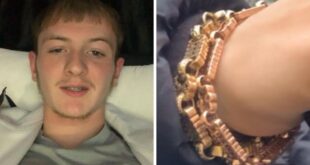- ITV Report
It has been quite a year for consumers, who spent accordingly to respond to a craze for tidying up, the hottest day on record, Love Island and Brexit.
This is what they bought, month by month.
– January
Putting things away became a huge money spinner when organisation expert Marie Kondo’s show Tidying Up hit UK television screens on January 2. Storage box sales soared by 47% and clothing hooks were up 36% for the month at John Lewis.
Online marketplace eBay said searches related to the cleaning guru surged by almost 200% in the week after the series premiere, and shoppers bought one packing box and nearly six storage boxes a minute to clear away items that no longer sparked joy. Lakeland reported sales of its interlocking drawer organiser set rising by a “phenomenal” 559%.
Even the British Heart Foundation got in on the act by urging British householders to donate items discarded during the decluttering frenzy to its stores.
– February
Consumer enthusiasm for Valentine’s Day reached new levels. John Lewis reported record spending related to the day of romance, with sales of confectionery up 80% on the previous week while alcohol gift sales bubbled up by 40%.
Poundland sold 20,000 £1 engagement rings in the space of seven days, packaging them in a box reading: “Because we promise they’ll want to choose their own.”
– March
The long-awaited second series of cult TV show Fleabag hit screens, with John Lewis reporting a 66% increase in sales of black jumpsuits and red lipstick as customers sought to emulate the look of its anti-hero.
A survey by Kantar found one in 10 shoppers claimed to be starting to stockpile food to prepare for a no-deal Brexit on March 31, although this was not reflected in grocery sales, which rose at a steady 1.2%.
– April
It was the hottest Easter Monday on record and the nation went into the garden. Sales of lawnmowers saw a 76% increase over the holiday weekend at John Lewis, while overall sales of gardening equipment were up 12%.
The warm weather boosted April sales of ice cream by 8% and hayfever remedies by 27%, while the average household took home 10 Easter treats during the longer build-up from February to the holiday weekend, Kantar reported.
– May
The arrival of the Duke and Duchess of Sussex’s first child, Archie, led to a 190% surge in sales of the £105 shawl he was wrapped in when he made his public debut.
Family business GH Hurt & Son said Archie’s appearance in the shawl triggered a shopping frenzy, revealing its website had 25,000 visitors in the following 24 hours, compared with the “hundreds” that would scroll through on a typical day.
– June
The World Cup brought women’s football into the spotlight, with more than a billion viewers for the first time. As the Lionesses reached their second consecutive semi-final, John Lewis saw sales of sport headbands increase by 76%. Visits from smartphones to its website during the ad break of the semi-finals increased by 4.5% and searches for womenswear and accessories accounted for 39% of total views.
– July
The UK experienced temperatures just above 38C on July 25, the hottest day ever recorded. Currys PC World said fan sales were up 200% while John Lewis reported selling six fans a minute.
Waitrose shoppers provided the supermarket with two of its biggest weeks ever for sales of rose wine, while also sending sales of English sparkling wine up 71% and Champagne up 27%.
Superdrug reported sales of cooling sprays rising by 116%, while sales of deodorants and body sprays were up 26% week on week following the temperature increase.
Meanwhile eBay reported a spike of 600% for searches for “Love Island”, with fans of the new series seeking out flamingo glasses, fire pits, naughty neon signs and water bottles.
– August
Shoppers endured a shortage of cauliflowers, cabbages and broccoli after heavy rain damaged crops in Lincolnshire earlier in the summer.
British Growers described the situation as “very concerning” after crops in the region were deluged with as much as six inches of rain in a week in June.
Meanwhile, Lakeland customers sent sales of SpiderEx and the Spider Catcher up by 25% and 14% respectively as they prepared for the annual influx, amid predictions the hot summer would see larger specimens than usual.
– September
Research found chicken shops were proving so popular on the high street that they were one of only three store types, along with pet shops and gyms, to see more openings than closures in the previous six months.
John Lewis said online shopping between the hours of midnight and 6am had increased by nearly a quarter in a year.
The annual September baby boom led to a baby item being sold on eBay every 20 seconds, including 35 buggies every hour for an average of £161.
– October
By mid October, households had spent £1.5 million on pumpkins ahead of Halloween, but predictions of stockpiling in preparation for a no-deal Brexit on October 31 were yet to translate into consistent sales.
Pumpkin sales were 29% higher than last year ahead of October 31, while John Lewis reported sales of Halloween trees, to be decorated with ghoulish baubles, were up 57% on last year.
Asda said it had sold more than 100,000 metres of “caution” tape along with 2,000 litres of fake blood, 40,000 cauldrons, 35,000 spider webs and 60,000 witch hats.
– November
The month began with shoppers having already spent £17 million on mince pies and £3 million on Christmas puddings, according to Kantar.
Shoppers were forecast to spend £2.53 billion on Black Friday on November 29, 3.4% more than last year, and £8.57 billion over the four days including Cyber Monday, according to a report by the Centre for Retail Research for VoucherCodes.co.uk.
Spending in the UK was predicted to be the highest in Europe.
– December
Christmas shoppers were warned to avoid buying fake toys after more than 50,000 teddy bears from China with loose eyes were destroyed at Felixstowe by trading standards officials.
Royal Mail’s survey of Christmas wishes sent from boys and girls to Father Christmas found video game consoles, Lego and bikes were among the most popular requests, along with books.
John Lewis said sales of Christmas trees were up 12% on last year, with the most popular height now 7ft compared with 4ft 10 years ago.
Source link



